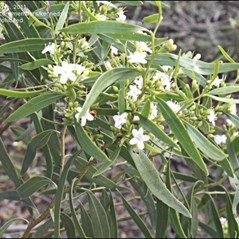Myoporum platycarpum
Sugarwood, False Sandalwood
Notes
Uses: Small hardy tree native to many dry areas of the country. Foliage has a weeping habit. Often seen more as a shrub. Can be lightly pruned to maintain shape.
Does best in well drained fertile soils.
This plant is indigenous to the following botanical regions of South Australia.
:NW: North Western
:LE: Lake Eyre
:NU: Nullarbor
:GT: Gairdner-Torrens
:FR: Flinders Rangers
:EA: Eastern
:EP: Eyre Peninsula
:NL: Northern Lofty
:MU: Murray
:YP: Yorke Peninsula
:SL: Southern Lofty
:SE: South Eastern
For detail on these regions refer to the user guide.
- Canopy Shape Domed
- Height 3-6m
- Spread 2-4m
- Position
- Full Sun
- Family Myoporaceae
- Botanical Name Myoporum platycarpum
- Common Name Sugarwood, False Sandalwood
- Origin SA, Vic, NSW, WA, Qld
- Habit Erect, Branches spreading to ascending
- Landscape Plains, Desert dunes, 2nd line coast, Coastal footslopes, Footslopes, Hills
- Soil Texture Sand, Loam
- pH Acidic, Alkaline, Neutral
- Tolerates Drought, Lime, Moderate frost
- Supplementary Watering Minimal
- Flower Colour White
- Flowering Time Spring, Winter
- Foliage Dark-green
- Flower Type Open-petalled
- Purpose Ornamental, Habitat
- Evergreen/Deciduous Evergreen
- Trunk Rough
- Form Small Tree (Up to 7m)
- Indigenous to the Adelaide Region







